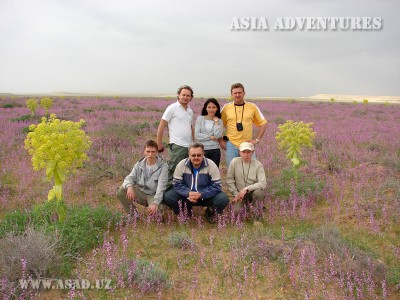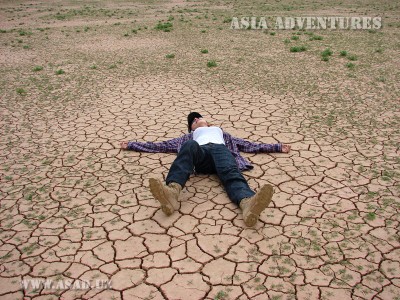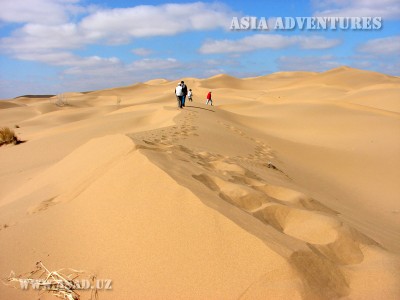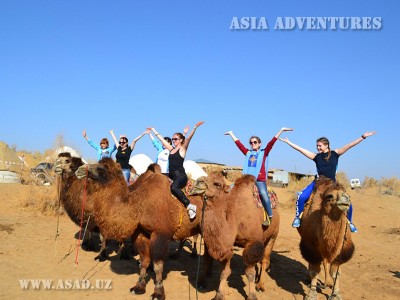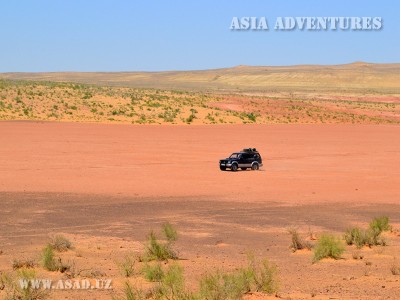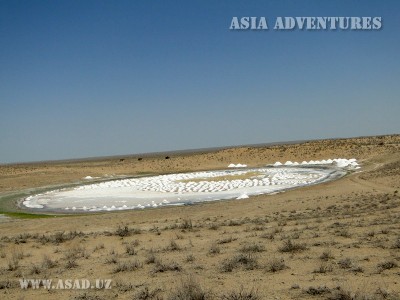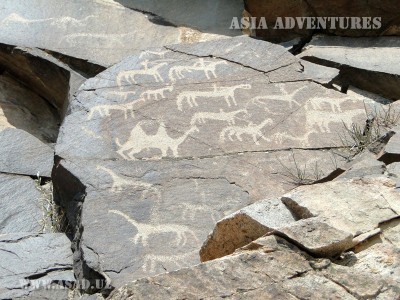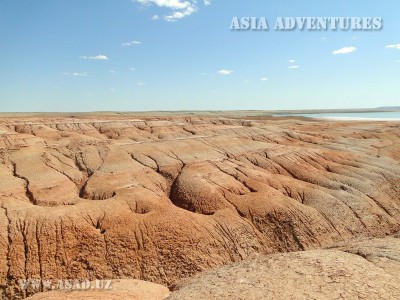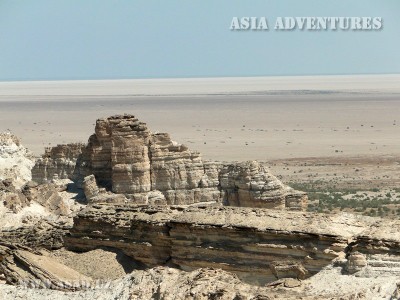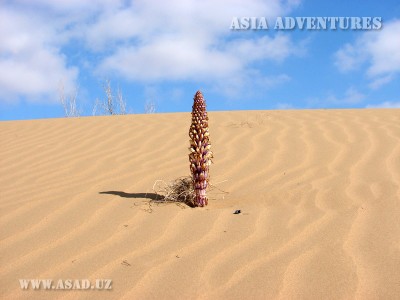
The Kyzylkum desert (Turkic ‘red sand’) is one of the most extensive deserts in Asia. The desert is situated between the Amudarya and Syrdarya rivers. Most of the Kyzylkum desert lies in the territory of Uzbekistan, with only a small portion of it extending to the territory of Kazakhstan. The Kyzylkum desert occupies an area of 300 thousand sq km and is bordered by the Syrdarya river from the northeast, by the Amudarya from the southwest, by the spurs of the Tien Shan and Pamir-Alay mountain ranges (Nurata Range) from the east, and by the Aral Sea and the Aralkum desert, a desert that has formed on the bottom of the former Aral Sea, from the northwest.
The Kyzylkum desert is a plain sloping generally northwestward (with an average elevation of 300 m above sea level in the southeast and 53 m in the northwest). The desert has a number of extensive closed depressions and isolated deeply-cut mountain ranges – Bukantau (764 m), Kuljuktau (up to 785 m), Tamdytau (972 m) and others. The largest portion of the desert is comprised of sand partially covered with vegetation, with some small areas of bare sand, however. Most of the sand ridges have a south-north orientation. The ridges rise 3 to 30 m above the surrounding area, some reaching even 75 m, though. The northwest part of the Kyzylkum desert features extensive clay areas (takyr) and areas of saline soil (solonchak).
The climate in the Kyzylkum desert is sharply continental, with hot summers (average temperature in July – from 26 °C to 29 °C, with a maximum of +51 °C ) and relatively cold winters (from 0 °C to –9 °C in January). The annual precipitation is low, from 100 mm to 200 mm, most of which falls in winter and spring. Apart from the Janadarya river drying up in hot seasons, there is no other superficial watercourse in the whole desert. However, it contains large amounts of subterranean fresh water.
Despite the water shortages, the Kyzylkum desert boasts diverse flora and fauna, which burst into life in spring time. The plant world is rich in ephemerals, including wild tulips and poppies growing richly across the whole area. The sedge (carex arenaria), the white saxaul (haloxylon persicum) and some species of Calligonum and Salsola richteri are common for the sandy areas, while various species of wormwood and shrubs are more typical of the clay soils. The valleys of dry river-beds are covered with forests of white and black saxauls.
The animals in the desert are able to live without water for a long time, taking most of the required quantity of liquid from their food. Many species are active at nighttime, which lessens their need for water. The mammal world of the Kyzylkum desert is represented by the goitered gazelle, long-clawed ground squirrel, Aral yellow souslik, sand cat, wolf, corsac fox, tolai hare and various species of gerbils, jerboas and bats, the last inhabiting the caves and grottos in the mountain areas. The birds living in the desert demonstrate high diversity of species: the crested lark, desert warbler, houbara bustard, saxaul desert jay, steppe eagle, various owls and others. Among the reptiles are snakes (blunt-nosed viper, Echis, sand boa, various colubrids and others), lizards (monitors, steppe agama and others), and the steppe tortoise.
The desert territories are utilised by the man for pasturing livestock – mostly sheep and camels. Large volumes of artesian water have been discovered in the central and western parts of the Kyzylkum desert. The water is used to create little artificial oases, where cattle farms are organised. Deposits of marble, graphite and turquoise have been found in the mountain regions of the desert. Several large gold mines have been developed in the desert, while the central regions contain uranium and phosphorites. The south of the Kyzylkum desert, and particularly the area in the neighbourhood of Gazli, is famous for its rich reserves of natural gas. Quite a number of settlements of various sizes can be found in the heart of the desert, among which are even relatively large towns and cities, such as Navoi, Zeravshan and Uchkuduk.
The Kyzylkum desert and the adjoining territories contain a number of objects, which are of interest to tourists.
Though the desert of Kyzylkum seems lifeless and boring at first sight, it is far from being so in reality, which is particularly noticeable in spring time, when the sand is covered with a carpet of poppies, tulips and blossoming shrubs, and the whole desert is lively with numerous animals. The most significant of the places of interest in the Kyzylkum desert are:
- the Aral Sea (the lake proper, the cemetery of ships in Muynak, the chinks (precipitous edges of the Ustyurt plateau) on the western shore, many-shaped and many-coloured isolated mountain ridges);
- the white sands of the Aralkum desert;
- the cultic monuments of Sultan-Uvays and Kaynar;
- a mountain in the form of a yurt;
- the concentration of high dunes in the central Kyzylkum desert;
- hot radon springs;
- petrified remains of dinosaurs in the Jurakuduk depression;
- a grove of ancient petrified trees;
- salt lakes (most of which are sources of common salt);
- ancient images cut on the walls of the Bukantau mountains;
- exotic villages of Kulkuduk, Yangigazgan and Dongelek lost amid the sands of the desert;
- the fortresses of ancient Khoresm;
- the extensive lake Aydar in the eastern pat of the Kyzylkum desert;
- the enormous fields of poppies and rare kinds of tulips in spring.
The Kyzylkum desert is a perfect place for jeep tours, car tours, rallies, bicycle tours and various types of ecological tours (biological, ornithological, botanical, herpetological, geological, landscape and other forms).
Rides on Bactrian camels, intensive tours, team building and other activities are organised within numerous yurt camps across the Kyzylkum desert.
There are a few interesting trekking, bicycle and horse routes across the mountains of Nuratau, Aktau and Karatau.

 Centralasia Adventures
+998712544100
Centralasia Adventures
+998712544100




